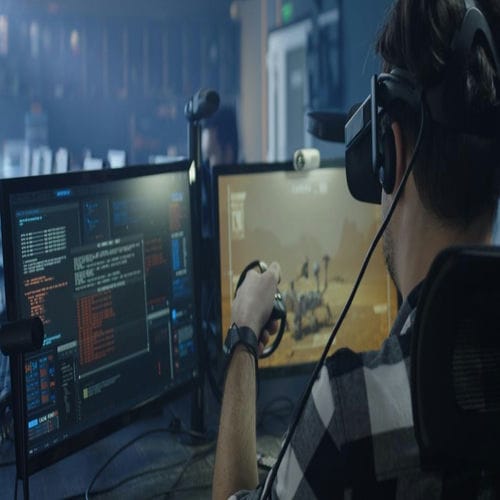Are you ready to learn how to become a full stack game developer? Are you prepared to enter the fast-paced world of game development and become a skilled full-stack developer?
In today’s digital era, gaming stands as a thriving multi-billion-dollar industry. Mastering full stack game development presents boundless opportunities, from crafting immersive narratives to refining technical skills.
Join us on a comprehensive journey to uncover the intricacies of becoming a full stack game developer. We’ll delve into core development principles, equip you with essential programming languages, and explore the realms of game design, backend, and frontend development.
By the end of this guide, you’ll gain knowledge and skills needed to bring your game ideas to life and create a niche for yourself in the exciting field of game development. So, let’s dive in and unlock the secrets to becoming a full stack game developer par excellence.
How To Be a Full Stack Game Developer?
Game development is a multifaceted discipline that combines creativity with technical expertise to create captivating interactive experiences. At its core, game development revolves around the creation of digital games, covering a wide range of game types and platforms.
Whether you’re passionate about action-packed adventures, immersive role-playing experiences, or mind-bending puzzles, the world of game development offers boundless opportunities for expression and innovation.
1. Overview of Game Engines and Programming Languages
Central to the process of game development are game engines, powerful software frameworks that provide developers with the tools and resources needed to bring their game ideas to life. From Unity and Unreal Engine to Godot and CryEngine, a myriad of game engines is available, each offering unique features and capabilities.
Additionally, mastering programming languages such as C++, C#, and Java are essential for implementing game logic, mechanics, and functionality within these engines.
2. Different Roles in Game Development
Game development is a collaborative endeavor that involves a diverse array of roles and specialties, each contributing to the creation of a cohesive and engaging gameplay experience. From game designers and programmers to artists, animators, and sound designers, every member of the development team plays a crucial role in shaping the final product.
Understanding the responsibilities and skill sets required for each role is essential for aspiring full stack game developers seeking to navigate the complexities of the game development process.
3. Importance of Interdisciplinary Skills
In the ever-evolving landscape of game development, possessing interdisciplinary skills is paramount to success. Full stack game developers must not only excel in their primary area of expertise but also possess a broad understanding of various disciplines, including programming, design, art, and sound.
By developing a diverse skill set and embracing a multidisciplinary approach, aspiring game developers can unlock new opportunities for innovation and creativity in their game projects.

Must read:
Developing Core Programming Skills
1. Learning Foundational Programming Languages
Mastering foundational programming languages forms the cornerstone of a full stack game developer’s skill set. Languages like C++, C#, and Java are widely used in game development for their versatility and performance.
By gaining proficiency in these languages, developers can effectively implement game mechanics, handle player input, and optimize game performance.
2. Object-Oriented Programming Principles
Object-Oriented Programming (OOP) is a fundamental concept in game development, emphasizing the organization of code into modular and reusable components.
Understanding OOP principles such as encapsulation, inheritance, and polymorphism enable developers to create well-structured and maintainable codebases. This, in turn, facilitates collaboration and scalability in game development projects.
3. Exploring Data Structures and Algorithms
Data structures and algorithms play a crucial role in optimizing game performance and efficiency. By familiarizing themselves with data structures such as arrays, lists, trees, and graphs, developers can efficiently manage and manipulate game data.
Likewise, knowledge of algorithms for tasks like pathfinding, collision detection, and sorting empowers developers to create responsive and immersive gameplay experiences.
4. Introduction to Version Control Systems
Version control systems like Git are indispensable tools for collaborative software development, including game development. By using version control, developers can track changes to their codebase, collaborate with team members, and revert to previous versions if needed.
Understanding the basics of version control ensures smooth and efficient workflow management throughout the game development process.
Mastering Game Design Principles
1. Game Design Fundamentals
At the heart of every successful game lies a well-crafted design. Game design encompasses the rules, mechanics, and aesthetics that shape the player’s experience. By mastering game design fundamentals, developers can create engaging and immersive gameplay experiences that resonate with players.
From conceptualizing game ideas to refining gameplay mechanics, understanding the principles of game design is essential for aspiring full stack game developers.
2. Exploring Game Mechanics, Dynamics, and Aesthetics
Game mechanics dictate how players interact with the game world, while dynamics describe how these interactions unfold over time. Aesthetics, on the other hand, encompass the visual and auditory elements that boost emotion and engagement.
By delving into game mechanics, dynamics, and aesthetics, developers can create games that are not only enjoyable but also meaningful and impactful.
3. Level Design and Game Balancing Techniques
Level design plays a crucial role in shaping the player’s journey through the game world. From pacing and progression to environmental storytelling and player feedback, every aspect of level design contributes to the overall player experience.
Additionally, mastering game balancing techniques ensures that the game remains challenging yet fair, keeping players engaged and motivated to progress.
4. Familiarizing with UX/UI Design Principles for Games
User experience (UX) and user interface (UI) design are essential components of modern game development. A well-designed UX/UI enhances player engagement, facilitates intuitive navigation, and enhances overall usability.
By applying UX/UI design principles customized to the unique requirements of game development, developers can create seamless and immersive user experiences that captivate and delight players.
By mastering these game design principles, aspiring full stack game developers can elevate their projects to new heights, creating games that captivate players and leave a lasting impression.

Trending topics:
- Which is Best Android Development OR Full Stack Web Development ?
- How to Become A Full Stack Mobile Developer?
Getting Hands-On with Game Engines
Game engines serve as the cornerstone of game development, providing developers with powerful tools and frameworks to bring their creative visions to life. Understanding the capabilities and features of popular game engines is essential for aspiring full stack game developers looking to embark on their game development journey.
1. Popular Game Engines
There exists a diverse array of game engines, each offering unique features and features are designed to accommodate various game genres and gaming systems. From industry giants like Unity and Unreal Engine to open-source alternatives like Godot, exploring and familiarizing oneself with these engines is paramount for aspiring developers.
2. Hands-On Tutorials
Practical experience is key to mastering game engines. Hands-on tutorials and projects allow developers to apply theoretical knowledge to real-world scenarios, refining their skills and understanding of game engine workflows.
By following step-by-step guides and creating simple games, developers can gain confidence and proficiency in using game engines effectively.
3. Understanding Pros and Cons
Each game engine has its strengths and weaknesses, and understanding these nuances is crucial for selecting the right engine for a particular project. Factors such as ease of use, performance, scalability, and community support should be considered when evaluating different game engines.
By delving into the world of game engines, aspiring full stack game developers can gain the skills and expertise needed to create immersive and captivating games across various platforms.
Leveraging Backend Development Skills
1. Backend Development
Backend development is the backbone of online gaming, powering features such as multiplayer functionality, player authentication, and data storage. For full stack game developers, proficiency in backend development is essential for creating dynamic and interactive gaming experiences.
2. Learning Server-Side Programming Languages
Mastering server-side programming languages such as Python, Node.js, and Ruby on Rails is fundamental to backend development. These languages enable developers to build robust backend systems that handle complex game logic, manage player data, and facilitate seamless communication between clients and servers.
3. Understanding Databases and Data Management
Databases play a crucial role in storing and retrieving game data, including player profiles, game progress, and in-game assets. Understanding database management systems (DBMS) and querying languages such as SQL is essential for designing efficient database schemas and optimizing data storage and retrieval processes.
4. Implementing Multiplayer Functionality
Multiplayer functionality is a hallmark of modern gaming, allowing players to connect and compete with others from around the world. Implementing multiplayer features requires a deep understanding of networking concepts, real-time communication protocols, and server architecture.
Read More:
Enhancing Frontend Development Skills
1. Frontend Development for Games
Frontend development is crucial for creating engaging and intuitive user interfaces (UI) in games. Full stack game developers must possess frontend development skills to design and implement UI elements that enhance the overall gaming experience.
2. Web Technologies for Game Development
Web technologies such as HTML5, CSS3, and JavaScript are widely used in frontend game development, especially for web-based and mobile games. Mastering these technologies enables developers to create responsive and visually appealing user interfaces that captivate players.
3. Implementing User Interfaces and Interactive Elements
User interfaces in games encompass a variety of elements, including menus, HUDs (heads-up displays), dialog boxes, and interactive buttons. Full stack game developers must know how to design and implement these UI components to provide players with seamless navigation and interaction throughout the game.
4. Optimizing Game Performance
Frontend optimization is essential for ensuring smooth gameplay experiences across different platforms and devices. Full stack game developers must optimize their frontend code to minimize load times, reduce memory usage, and maximize frame rates, especially for resource-intensive games.
By honing their frontend development skills, full stack game developers can create visually stunning games with intuitive user interfaces that keep players engaged and immersed in the gaming experience.

Exploring Game Art and Asset Creation
1. Game Art Styles and Aesthetics
Game art encompasses the visual elements that bring game worlds to life, including character designs, environments, animations, and special effects. Understanding different art styles and aesthetics is crucial for full stack game developers seeking to create immersive and visually appealing gaming experiences.
2. Learning 2D and 3D Graphics Software
Mastering 2D and 3D graphics software such as Photoshop, Blender, Maya, and 3ds Max is essential for creating game assets. These tools enable developers to design and model characters, props, and environments, as well as texture and animate them to breathe life into the game world.
3. Creating Game Assets
Game assets are the building blocks of any game, ranging from sprites and textures in 2D games to models and animations in 3D games. Full stack game developers must know how to create and optimize these assets to ensure optimal performance and visual fidelity in their games.
4. Importance of Visual Storytelling
Visual storytelling plays a crucial role in engaging players and conveying narrative elements within games. Full stack game developers must understand how to use visuals, animations, and cinematography techniques to effectively communicate story beats, character motivations, and thematic elements to players.
Collaborating and Working in Teams
1. Importance of Teamwork in Game Development
Game development is inherently collaborative, requiring coordination and cooperation among team members with diverse skill sets. Full stack game developers must understand the importance of teamwork and effective communication to successfully bring their game projects to realization.
2. Best Practices for Effective Communication
Clear and concise communication is essential for smooth collaboration in game development teams. Full stack game developers should adopt best practices such as regular team meetings, utilizing project management tools, and establishing clear channels of communication to ensure everyone is on the same page.
3. Leveraging Version Control Tools
Version control tools like Git are invaluable for collaborative software development, allowing team members to track changes, collaborate on code, and maintain project integrity. Full stack game developers should familiarize themselves with version control workflows to streamline collaboration and minimize conflicts.
4. Case Studies and Success Stories
Studying case studies and success stories of successful game development teams can provide valuable insights and inspiration for aspiring full stack game developers. Analyzing how successful teams approach collaboration, problem-solving, and project management can help developers glean valuable lessons and apply them to their own projects.
Building and Publishing Your Own Games
1. Bringing Concepts to Life
After acquiring the necessary skills and knowledge, full stack game developers embark on the exciting journey of bringing their game concepts to life. From brainstorming and prototyping to iteration and refinement, the game development process is a rewarding blend of creativity and technical expertise.
2. Strategies for Testing and Debugging
Thorough testing and debugging are crucial stages in game development to ensure a polished and bug-free final product. Full stack game developers employ a variety of testing strategies, including unit testing, integration testing, and user testing, to identify and address any issues or bugs that may arise during development.
3. Publishing on Different Platforms
Publishing a game on various platforms opens up opportunities to reach a wider audience and maximize exposure. Full stack game developers must understand the requirements and specifications of different platforms, whether it’s PC, console, mobile, or web, and optimize their game accordingly for a seamless user experience.
4. Marketing and Promotion
Effective marketing and promotion are essential for the success of any game. Full stack game developers must develop a marketing strategy that encompasses social media, press releases, game trailers, and community engagement to generate hype and excitement for their game leading up to launch.
Continuing Education and Career Growth
1. Resources for Further Learning
The field of game development is constantly evolving, with new technologies, tools, and techniques emerging regularly. Full stack game developers must stay updated with the latest trends and advancements by leveraging a variety of resources, including online courses, tutorials, books, and workshops.
2. Networking Opportunities and Communities
Networking with fellow game developers and industry professionals is invaluable for career growth and opportunities. Full stack game developers can join online forums, attend conferences, and participate in game jams to connect with like-minded individuals, share knowledge, and collaborate on projects.
3. Exploring Career Paths
The game industry offers a multitude of career paths and opportunities for full stack game developers, ranging from indie game development and freelance work to employment at game studios and AAA companies. Understanding the different career paths available and identifying one’s strengths and interests is essential for long-term career growth and success.
4. Staying Updated with Emerging Technologies
Emerging technologies such as virtual reality (VR), augmented reality (AR), and artificial intelligence (AI) are shaping the future of game development. Full stack game developers should stay abreast of these technologies and explore opportunities to incorporate them into their projects to stay competitive in the ever-evolving game industry.
Conclusion
Becoming a full stack game developer is an exciting and rewarding journey that requires dedication, skill, and passion for the craft. By mastering programming languages, game design principles, and backend/frontend development, you can unleash your creativity and bring your game ideas to life.
Remember to continually educate yourself, collaborate with others, and stay updated with industry trends to excel in this dynamic field.
Start your journey towards becoming a full stack game developer today with the help of Devtrain.co.


